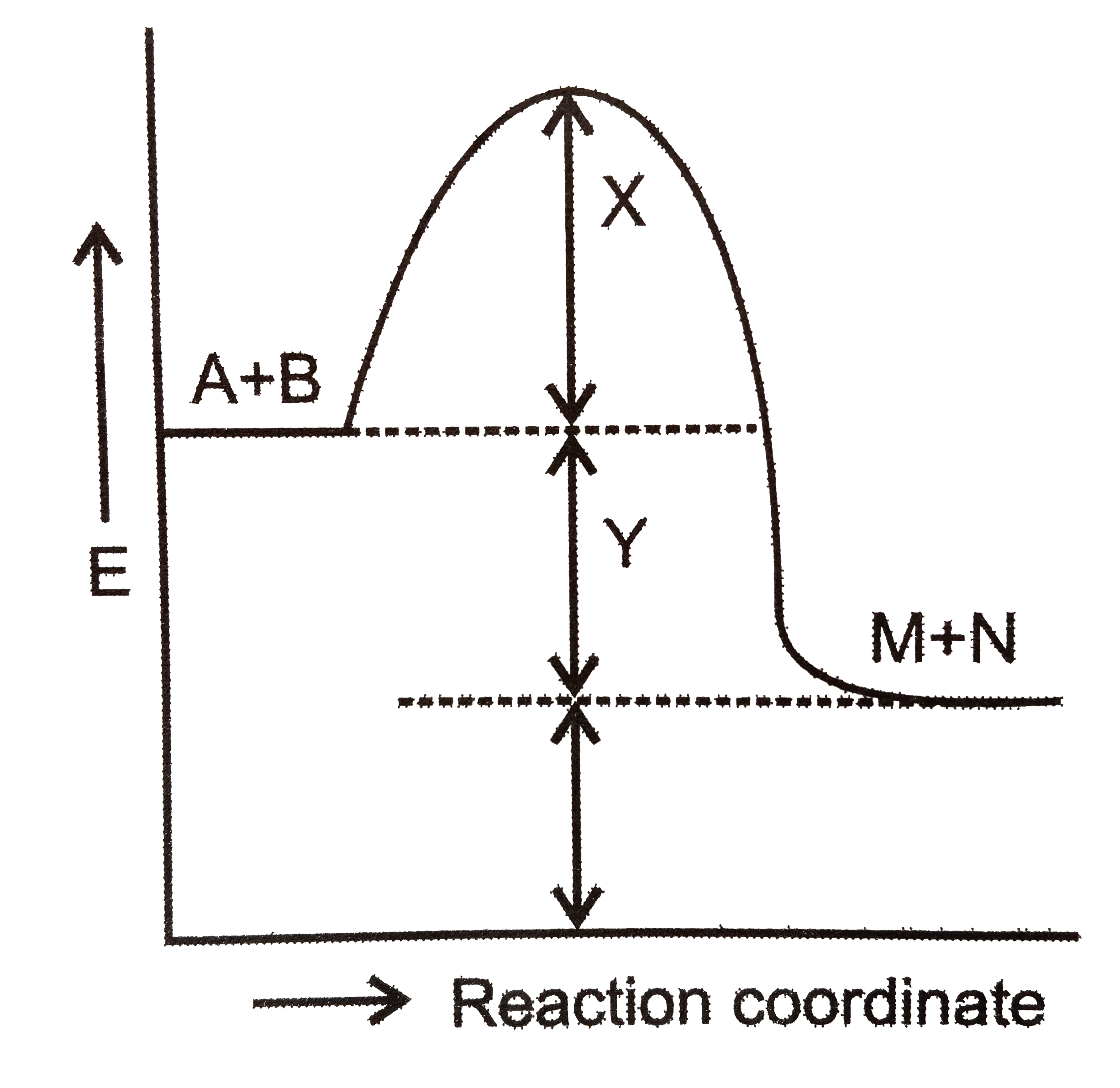The energy of activation of a forward reaction is 50 kcal . The energy of activation of its backward reaction is
equal to 50 kcal
greater then 50 kcal
less than 50 kcal
either greater or less than 50 kcal
The correct Answer is:D
To determine the energy of activation for the backward reaction when the energy of activation for the forward reaction is given as 50 kcal, we can use the following approach:
1. Understand Activation Energy:
- The activation energy (Ea) is the minimum energy required for a chemical reaction to occur. For a forward reaction, this is the energy needed to convert reactants into products.
2. Identify the Forward Reaction:
- In this case, the activation energy for the forward reaction is given as 50 kcal.
3. Consider the Backward Reaction:
- The backward reaction is the reverse of the forward reaction. The activation energy for the backward reaction (Ea backward) can be determined by considering the difference in energy between the reactants and products.
4. Energy Diagram:
- Draw an energy diagram where the y-axis represents energy and the x-axis represents the reaction coordinate.
- Mark the energy level of the reactants and products. The activation energy for the forward reaction is the height of the energy barrier from the reactants to the top of the energy hill (transition state).
5. Relate Forward and Backward Activation Energies:
- The energy of activation for the backward reaction can be calculated using the formula:
Ea(backward)=Ea(forward)+ΔH
- Here, ΔH is the change in enthalpy of the reaction, which is the difference in energy between products and reactants.
6. Conclusion:
- Without specific values for the enthalpy change (ΔH), we cannot determine a precise value for the backward activation energy. It can be either greater than, less than, or equal to 50 kcal depending on whether the reaction is exothermic or endothermic.
Final Answer:
- The energy of activation for the backward reaction can be greater than, less than, or equal to 50 kcal, depending on the enthalpy change of the reaction.
- The activation energy (Ea) is the minimum energy required for a chemical reaction to occur. For a forward reaction, this is the energy needed to convert reactants into products.
- In this case, the activation energy for the forward reaction is given as 50 kcal.
- The backward reaction is the reverse of the forward reaction. The activation energy for the backward reaction (Ea backward) can be determined by considering the difference in energy between the reactants and products.
- Draw an energy diagram where the y-axis represents energy and the x-axis represents the reaction coordinate.
- Mark the energy level of the reactants and products. The activation energy for the forward reaction is the height of the energy barrier from the reactants to the top of the energy hill (transition state).
- The energy of activation for the backward reaction can be calculated using the formula:
Ea(backward)=Ea(forward)+ΔH
- Here, ΔH is the change in enthalpy of the reaction, which is the difference in energy between products and reactants.
- Without specific values for the enthalpy change (ΔH), we cannot determine a precise value for the backward activation energy. It can be either greater than, less than, or equal to 50 kcal depending on whether the reaction is exothermic or endothermic.
- The energy of activation for the backward reaction can be greater than, less than, or equal to 50 kcal, depending on the enthalpy change of the reaction.
Topper's Solved these Questions
- CHEMICAL KINETICSBOOK - RC MUKHERJEECHAPTER - CHEMICAL KINETICSEXERCISE - PROBLEMS
42 Videos
- CHEMICAL EQUIVALENCEBOOK - RC MUKHERJEECHAPTER - CHEMICAL EQUIVALENCEEXERCISE - PROBLEMS
24 Videos
- CHEMICAL THERMODYNAMICSBOOK - RC MUKHERJEECHAPTER - CHEMICAL THERMODYNAMICSEXERCISE - Objective problems
58 Videos
Similar Questions
For a reaction A+B+30 kcal→Product the energy of activation of its backward reaction is "50" kcal. The energy of activation of its forward reaction is
View SolutionFrom the given figure:
i) Calculate ΔE for the reaction and energy of activation for the forward reaction and energy of activation for the backward reaction.
ii) The dotted curve is in the presence of a catalyst, what is the energy of activation for the two reactions in the presence of the catalyst?
iii) will the catalyst change the extent of the reaction?

View Solution
Knowledge Check
For a reversible reaction, A+B?C+D,ΔH=–A kcal. If energy of activation for the forward reaction is B kcal, the energy of activation for backward reaction in kcal is :
A−A+BBA+BCA−BD−A−Bin a reversible reaction the energy of activation of the forward reaction is 50 kcal .
the energy of activation for the reverse reaction will beAlt 50 kcalB50 kcalCeither greater tan or less than 50 kcalDgt 50 kcalGiven : A⇔B+C,ΔH=−10 kcals, the energy of activation of backward reaction is 15 kcal mol−1. If the energy of activation of forward reaction in the presence of a catalyst is 3 kcal mol−1 the catalyst will increase the rate of reaction at 300 K by the number of times equal to
Ae3.33Be4.21Ce−2.7De2.303
Consider the following figure for the reaction:
A+B→M+N

Answer the following:
(a) Energy level of (A+B)
(b) Energy level of (M+N)
(c ) Threshold energy level for the reaction.
(d) Energy of activation for the forward reaction.
(e) Energy of activation for the backward reaction.
(f) ΔH or heat of reaction.
View SolutionGiven that the enthalpy change of a reaction at 325 K is 0.12 kcal and energy of activation for the backward reaction is 0.02 kcal, calculate the percentage of the reactant molecules, crossing over the energy barrier.
View SolutionFor A+B→C+D,ΔH=−20kJmole−1. The activation energy for the forward reaction is 85 kJ. Then the activation energy for the backward reaction is ___
View SolutionConsider the following reaction,
N2(g)+3H2(g)⇔2NH3(g)+22kcal mol−1
The activation energy for the forward reaction is 50 kcal. What is the activation energy for the backward reaction?
View SolutionFor A+B→C+D,ΔH=−20kJmol−1, the activation energy of the forward reaction is 85kJmol−1. The activation energy for backward reaction is …… kJmol−1.
View Solution
